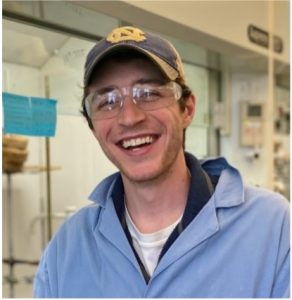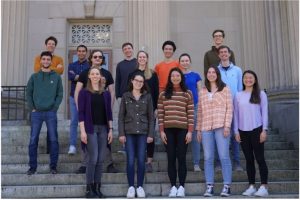Customer case study



Earlier this year, a collaboration between three members of the UNC-Chapel Hill Department of Chemistry and ITS Research Computing yielded interesting publishable findings.
Pedro de Jesús Cruz, now Senior Research Scientist at Merck, was a Ph.D. candidate, Research Assistant and NIH F32 Graduate Fellow in the UNC Department of Chemistry in the College of Arts and Sciences.
Evan Crawford is a Research Assistant and Ph.D. candidate in the Department of Chemistry.
Their thesis adviser is Professor Jeffrey Johnson, A. Ronald Gallant Distinguished Professor of Chemistry and former Departmental Chairperson. Cruz, Crawford and Johnson are clients of ITS Research Computing.
The clients
Synthesizing cancer-curing drugs and other medicinally essential reagents from natural products is challenging. One key puzzle is the transformation and selection of chirality of molecules. Chirality, i.e., handedness, means that a molecule is distinguishable when superimposed on its mirror image — like a right and left hand. Chirality explains how molecules with the same formula can have a different arrangement of atoms.

Cruz, Crawford and Johnson work on these challenges, with a specific focus on stereoselective catalysis. With stereoselective catalysis, scientists control the reaction to produce specific products. Cruz, Crawford and Johnson’s work is guided by the idea that developing generalizable synthetic chemistry platforms based on catalytic stereoselective reactions enables scientists to gain the myriad benefits of molecular complexity by beginning with simple, readily available starting materials. These benefits are particularly applicable to scientists broadly engaged in biomedical research.
Cruz, Crawford and Johnson begin with metal-based catalysts, then modify the organic scaffold around the metal to modulate the chemical environment that influences the three-dimensional arrangement. These modulations ultimately control how reactants assemble, including the “handedness” of the resulting molecules.
The challenge
During their research, Cruz and Crawford discovered a new copper-catalyzed reaction. β-keto esters, foundational building blocks that played a role in the 2001 Nobel Prize for Chemistry, act as the simple readily available starting materials. The reaction is a cyclization, or ring-forming reaction, that uses the catalyst and a boron compound to stitch together the two ends of the molecule.
The reaction is complex and creates a product containing four asymmetric tetrahedral carbon atoms. As a result, 24 products with the same molecular weight and connectivity are possible due to the asymmetric shape.
Cruz and Crawford discovered promising catalysts and conditions that led to the formation of only two major products. While chemical structural studies through nuclear magnetic resonance (NMR) spectroscopy and X-ray diffraction (XRD) studies enabled the team to understand what had been formed, it was unclear why the products had been formed in the way they were.
The solution

To explain the mechanism and figure out the microscopic details of the reactions, Cruz, Crawford and Johnson collaborated with Shubin Liu, Ph.D., Senior Computational Scientist in ITS Research Computing and adjunct professor in the Department of Chemistry. Liu is an expert in density functional theory (DFT) computational modeling. DFT modeling is widely used in physics, chemistry and biology to explore the structure of atoms and molecules.
Liu conducted high-level calculations on the proposed reaction intermediates and on what the molecule looks like as it traverses high-energy barriers called transition states. The calculations revealed that the transition states are critical — it is in the transition states that reaction selectivity is determined and the three-dimensional atomic arrangements established.
Using the Longleaf cluster, a Linux-based computing system with nearly 6,500 compute cores, and Research Computing’s Gaussian software package, Liu determined the structure of the active catalyst that Cruz and Crawford developed. From there, Liu was able to computationally study the microscopic details of how and why the reactions proceed in such a selective manner.
The results
Liu’s DFT studies provided a complete snapshot of the competing transition states leading to possible products. His computational results agreed with Cruz and Crawford’s experimental findings. In conjunction with experimental mechanistic studies that involved in situ monitoring of reactions using NMR spectroscopy, the computational work helped provide a unified picture of the catalytic cycle and selectivity determining steps.
The results, published in the Journal of the American Chemical Society (JACS), one of the top-tier and most-cited journals in chemistry, challenged a central dogma that has lingered about β–keto esters since the foundational work done with them in the 1980s.
The future
Stereoselective reactions are at the core of Cruz, Crawford and Johnson’s research and organic chemistry generally. In parallel with rigorous experimental work, high-level theoretical work is essential for current research to inform future advances.
Johnson’s team continues to be interested in how the contours (peaks and valleys) of potential energy surfaces can influence product selectivity in the discovery of new organic transformations and their application to the total synthesis of architecturally challenging and biologically important natural products. DFT studies will remain a central piece of the mechanistic puzzle needed to complete the picture.
Johnson’s group and Liu are currently collaborating on a number of ongoing experimental projects. Johnson said that he anticipates more fruitful collaborations with Liu in the coming months.
